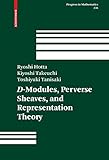D-modules, perverse sheaves, and representation theory
Material type: TextSeries: Progress in Mathematics ; Vol. 236Publication details: Boston: Birkhauser, [c2008]Description: 407 pISBN: 9780817643638LOC classification: QA179Online resources: Click here to access online
TextSeries: Progress in Mathematics ; Vol. 236Publication details: Boston: Birkhauser, [c2008]Description: 407 pISBN: 9780817643638LOC classification: QA179Online resources: Click here to access online | Item type | Current library | Collection | Shelving location | Call number | Status | Notes | Date due | Barcode | Item holds |
|---|---|---|---|---|---|---|---|---|---|
 Book
Book
|
ICTS | Mathematic | Rack No 4 | QA179 (Browse shelf (Opens below)) | Available | Invoice no. IN00 7067 ; Date 21-02-2019 | 01737 |
PART I- D-Modules and Perverse Sheaves
1. Preliminary Notions
2. Coherent D-Modules
3. Holonomic D-Modules
4. Analytic D-Modules and the de Rham Functor
5. Theory of Meromorphic Connections
6. Regular Holonomic D-Modules
7. Riemann–Hilbert Correspondence
8. Perverse Sheaves
PART - II Representation Theory
9. Algebraic Groups and Lie Algebras
10. Conjugacy Classes of Semisimple Lie Algebras
11. Representations of Lie Algebras and D-Modules
12. Character Formula of HighestWeight Modules
13. Hecke Algebras and Hodge Modules
D-modules continues to be an active area of stimulating research in such mathematical areas as algebra, analysis, differential equations, and representation theory.
Key to D-modules, Perverse Sheaves, and Representation Theory is the authors' essential algebraic-analytic approach to the theory, which connects D-modules to representation theory and other areas of mathematics. Significant concepts and topics that have emerged over the last few decades are presented, including a treatment of the theory of holonomic D-modules, perverse sheaves, the all-important Riemann-Hilbert correspondence, Hodge modules, and the solution to the Kazhdan-Lusztig conjecture using D-module theory. --- summary provided by publisher


There are no comments on this title.